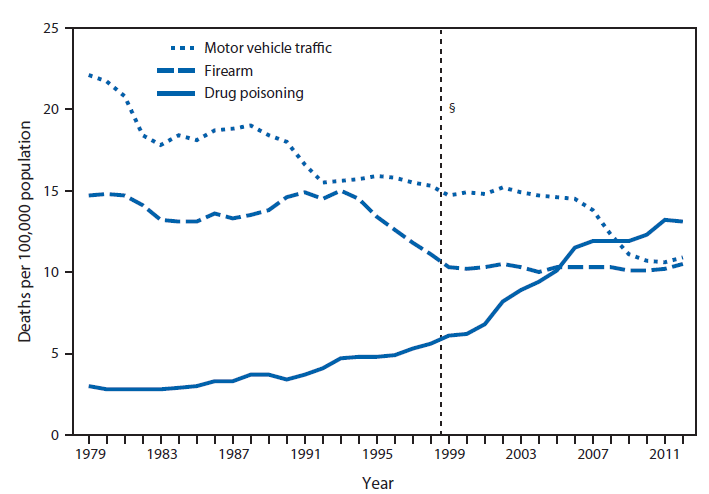A study published February 9 in the Journal of the American Medical Association points to three reasons for the life expectancy being lower for Americans than in other developed nations. Care to guess what they are?

"Guns, drugs and motor vehicle crashes account for half of the life-expectancy gap between men in the United States and other high-income countries, according to a study published Tuesday in the Journal of the American Medical Association," writes Carolyn Y. Johnson, a reporter covering the business of health for The Washington Post.
The circle chart shows how much each of the causes reduces life expectancy in men:
- Gun violence: 5.4 months
- Drug poisoning, which includes overdoses: 3.6 months
- Motor vehicle crashes: 3.4 months
A corresponding chart points to the same three reasons for lower life expectancy for American women, though the number of months is smaller. Drugs, motor vehicles, and guns, in that order, are the main causes.
The study is significant because American medicine may be focusing on the wrong causes for the lower life expectancy in the United States, "about 2.2 years earlier than their counterparts in a dozen other high-income countries, according to 2012 data," writes Johnson. Traditional health issues such as "chronic disease, obesity, smoking or access to health care" have been its focus.
Gun, drugs, and motor vehicles are by no means strictly American causes of death, but they affect American far more than in other developed nations, so much so that they account for "a full year -- about half of the disadvantage that American men face" in the United States than elsewhere, according to Andrew Fenelon, a researcher with the National Center for Health Statistics, a division of the Centers for Disease Control and Prevention (CDC), and one of three authors of the study.

Credit: CDC, Nov. 21, 2014
In a related Wonkblog piece, Johnson and Christopher Ingraham delve into how gun violence replaced traffic crashes as the leading cause of preventable death.
"The CDC had not touched firearm research since 1996 — when the NRA accused the agency of promoting gun control and Congress threatened to strip the agency’s funding," wrote Todd C. Frankel for The Washington Post last year.
Hat tip to Michael Keenly
FULL STORY: Three very American reasons why we’re still so unhealthy

Planetizen Federal Action Tracker
A weekly monitor of how Trump’s orders and actions are impacting planners and planning in America.

Chicago’s Ghost Rails
Just beneath the surface of the modern city lie the remnants of its expansive early 20th-century streetcar system.

Amtrak Cutting Jobs, Funding to High-Speed Rail
The agency plans to cut 10 percent of its workforce and has confirmed it will not fund new high-speed rail projects.

The French Solution to Congested Tunnels: Make Them Car-Free
Bay Area transportation officials keep expanding car capacity. Lyon’s Croix Rousse Tunnel offers a different way.

Missouri Governor Reverses Anti-Discrimination Housing Policies
A new state law bars cities from prohibiting source-of-income discrimination against tenants using Section 8 housing vouchers.

USDOT Launches Unfunded 'SAFE ROADS' Program
The program targets “distractions” and “political messages or artwork,” and paves the way for autonomous vehicles.
Urban Design for Planners 1: Software Tools
This six-course series explores essential urban design concepts using open source software and equips planners with the tools they need to participate fully in the urban design process.
Planning for Universal Design
Learn the tools for implementing Universal Design in planning regulations.
City of Fort Worth
planning NEXT
Mpact (founded as Rail~Volution)
City of Camden Redevelopment Agency
City of Astoria
City of Portland
City of Laramie




























